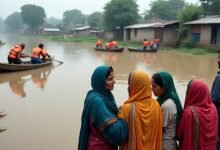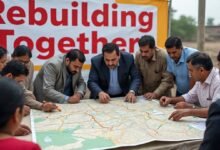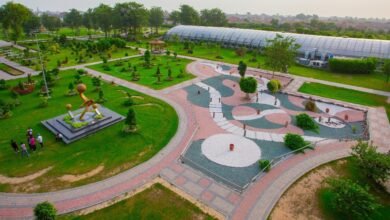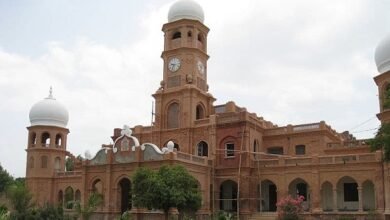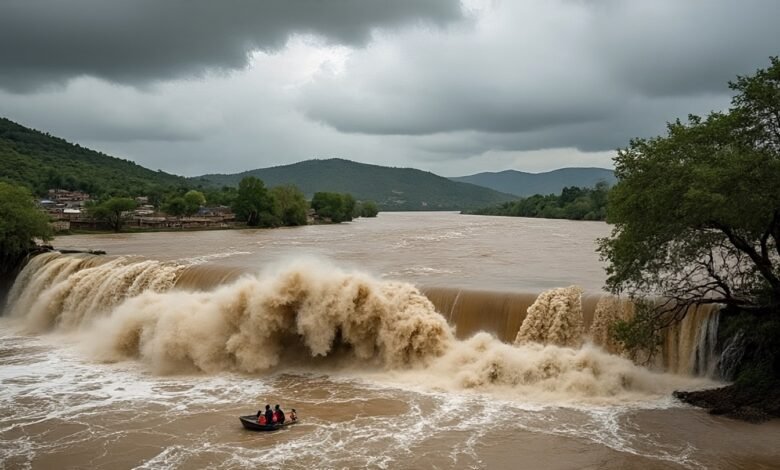
How Sutlej River Floods Disrupt Lives and Livelihoods in South Punjab
Sutlej River floods devastate South Punjab, displacing millions, destroying crops, and disrupting livelihoods across Pakistani communities annually.
The Sutlej River floods have become a recurring nightmare for millions living in South Punjab, Pakistan’s agricultural heartland. These devastating floods, which have intensified in recent years due to climate change and upstream water releases, represent far more than just rising water levels. They symbolize the complete disruption of entire communities, the destruction of generations-old farming traditions, and the displacement of families who call the fertile plains of Pakistani Punjab home.
In 2025 alone, Sutlej River floods affected over 2 million people across South Punjab, making it the worst flooding disaster in the region’s recorded history. From the border districts of Kasur and Bahawalnagar to the cotton-producing areas of Muzaffargarh and Multan, entire villages have been submerged, standing crops destroyed, and families forced to abandon their homes with nothing but the clothes on their backs. The human cost extends beyond immediate displacement, creating long-term challenges for food security, economic stability, and social cohesion in Pakistan’s most productive agricultural region.
Understanding the Sutlej River System in the Pakistani Context
Geographic Significance and Cross-Border Challenges
The Sutlej River, stretching 1,400 kilometers from the Himalayas to its confluence with the Chenab, represents both a lifeline and a source of vulnerability for South Punjab communities. As the longest tributary of the Indus River system, the Sutlej originates in southwestern Tibet, flows through Indian states of Himachal Pradesh and Punjab, before crossing into Pakistan’s Punjab province near Fazilka-Kasur border.
This cross-border nature of the Sutlej River creates unique challenges for Pakistani Punjab flood management. Under the Indus Waters Treaty of 1960, India controls the eastern rivers including the Sutlej, Ravi, and Beas, while Pakistan manages the western rivers. However, this arrangement means that Pakistani communities in South Punjab remain vulnerable to upstream decisions made across the border, often with limited advance warning or coordination.
The 2025 Flood Crisis: Unprecedented Scale and Impact
The 2025 Sutlej River floods marked a watershed moment for disaster management in Pakistani Punjab. According to Punjab Provincial Disaster Management Authority (PDMA), the floods affected over 4,500 villages and displaced more than 2.4 million people across South Punjab districts. The scale was unprecedented, with three major rivers – Sutlej, Chenab, and Ravi – simultaneously carrying record-high water volumes.
Key Statistics of 2025 Floods:
- 2.4 million people affected across South Punjab
- 4,500 villages completely or partially submerged
- 400,000 acres of agricultural land damaged
- 97 lives lost in Pakistani Punjab alone
- 530,000 people evacuated between August-September
How Sutlej River Floods Devastate Agricultural Livelihoods
Crop Destruction and Food Security Crisis
Agriculture forms the backbone of South Punjab’s economy, with the region contributing significantly to Pakistan’s wheat, rice, cotton, and sugarcane production. When Sutlej River floods occur, they don’t just damage individual farms – they threaten national food security and the livelihoods of millions dependent on agriculture.
The 2025 floods destroyed standing crops across more than 400,000 acres in South Punjab, with rice paddies, cotton fields, and vegetable farms bearing the brunt of the devastation. Farmers like Muhammad Akram from Bahawalnagar district lost their entire seasonal harvest just weeks before the planned harvest, representing months of investment in seeds, fertilizers, and labor completely washed away.
Agricultural Impact Breakdown:
- Rice crops: 60% of standing paddy destroyed in flood-affected areas
- Cotton production: Estimated losses exceeding PKR 50 billion
- Vegetable farms: Complete loss of seasonal vegetables in riverine areas
- Livestock: Over 1.9 million cattle relocated, many permanently lost
Long-term Economic Disruption
The economic ripple effects of Sutlej River floods extend far beyond immediate crop losses. Small-scale farmers, who constitute the majority of agricultural workers in South Punjab, often lack adequate insurance coverage or financial reserves to recover quickly from flood damage. This creates a cycle of debt and poverty that can persist for years after the floodwaters recede.
Kausar Bibi, a landless agricultural laborer from Dhoop Sari village near the Pakistan-India border, exemplifies this challenge. After the floods washed away local crops, she lost her primary source of employment, forcing her family deeper into poverty. “We can go sit on the bund, but what do we do there?” she told researchers, highlighting the inadequate support systems for the most vulnerable flood victims.
Human Displacement and Social Disruption
Mass Evacuation and Relief Camp Challenges
The human cost of Sutlej River floods in Pakistani Punjab extends far beyond statistics. When flood warnings are issued, families face impossible choices: abandon their homes and livelihoods immediately or risk being trapped by rapidly rising waters. The 2025 floods forced the largest mass evacuation in South Punjab’s history, with over 530,000 people moved to temporary relief camps.
These relief camps, often established in schools, mosques, and government buildings, provide basic shelter but struggle to maintain dignity and privacy for displaced families. Pregnant women, elderly residents, and children face particular hardships in overcrowded facilities with limited medical care and sanitation facilities.
Relief Camp Statistics:
- 404 relief camps established across South Punjab
- 488 medical camps providing healthcare
- 421 veterinary camps for livestock care
- Average stay: 3-4 weeks per family
Women and Children: Disproportionate Impact
Sutlej River floods disproportionately affect women and children in South Punjab communities. Cultural constraints often prevent women from learning swimming or flood survival skills, making them more vulnerable during evacuation scenarios. Pregnant women face additional risks, with limited access to prenatal care and safe delivery facilities in crowded relief camps.
Shumaila Riaz, 19 years old and seven months pregnant, spent four days in a relief camp during the 2025 floods, enduring pregnancy complications without adequate medical support. Her experience highlights the urgent need for gender-sensitive disaster preparedness in Pakistani Punjab flood zones.
Cross-Border Water Management and Diplomatic Tensions
The Indus Waters Treaty Challenge
The management of Sutlej River floods involves complex diplomatic relations between India and Pakistan, governed by the 1960 Indus Waters Treaty. While this agreement allocates water usage rights, it provides limited mechanisms for coordinating flood management, early warning systems, or emergency response protocols.
Pakistani officials have repeatedly accused India of deliberately releasing water from upstream dams to cause flooding in South Punjab. However, hydrological experts suggest that reservoir management during monsoon seasons involves difficult technical decisions balancing flood control with water storage needs.
Climate Change and Intensifying Patterns
Recent studies indicate that climate change is intensifying monsoon patterns across the Himalayan region, leading to more frequent and severe flooding events. The Intergovernmental Panel on Climate Change projects a 20% increase in extreme rainfall events for the Indian subcontinent due to warming temperatures, suggesting that Sutlej River floods may become more frequent and devastating in coming decades.
This climate reality demands improved bilateral cooperation between India and Pakistan for flood management, moving beyond political tensions to focus on shared hydrological challenges affecting millions on both sides of the border.
Disaster Management and Response Systems
Provincial and Federal Response Mechanisms
Pakistani Punjab has developed increasingly sophisticated disaster response systems following previous flood disasters in 1988, 2010, and 2023. The Punjab Provincial Disaster Management Authority (PDMA) now operates early warning systems, coordinates multi-agency responses, and maintains pre-positioned relief supplies across South Punjab districts.
However, the 2025 Sutlej River floods exposed significant gaps in preparedness and response capacity. Despite advance warnings, many communities lacked clear evacuation plans, adequate transportation, or sufficient relief supplies to handle mass displacement scenarios.
Response System Components:
- Early warning systems via social media and SMS
- Multi-agency coordination (Army, NDRF, local administration)
- Pre-positioned relief supplies and equipment
- Emergency medical response teams
- Livestock evacuation and care protocols
Community-Based Resilience Initiatives
Some South Punjab communities have developed innovative approaches to flood resilience, drawing on traditional knowledge and modern techniques. Villages along the Sutlej have revived ancient practices of building elevated grain storage, maintaining community boat fleets, and establishing mutual aid networks for emergency response.
The village of Haku Wala, located near the Pakistan-India border, has established a community-based early warning system using local volunteers to monitor water levels and coordinate evacuation procedures. While still surrounded by floodwaters weeks after the 2025 floods, residents like retired air force officer Saeed Akhtar remain determined to rebuild their community with improved flood resilience.
Environmental and Infrastructure Consequences
Ecosystem Disruption
Sutlej River floods create significant environmental consequences beyond immediate human impact. Floodwaters carry agricultural chemicals, urban sewage, and industrial waste across vast areas, contaminating groundwater sources and disrupting local ecosystems. Cities like Multan and Muzaffargarh faced additional challenges when flood-swollen rivulets carrying industrial waste overflow into residential areas.
The floods also disrupt natural wetland systems that traditionally provide flood control and water filtration services. Development pressures and agricultural encroachment into flood plains have reduced these natural buffers, intensifying flood impacts in downstream communities.
Infrastructure Damage and Reconstruction Challenges
The 2025 Sutlej River floods caused extensive damage to critical infrastructure across South Punjab, including roads, bridges, schools, hospitals, and telecommunications networks. Rural areas faced particular challenges with damaged tube wells, irrigation channels, and storage facilities essential for agricultural production.
Reconstruction efforts face the challenge of building resilience into infrastructure design while managing limited resources and competing priorities. The World Bank’s disaster risk management framework emphasizes building back better rather than simply restoring previous infrastructure that proved vulnerable to flooding.
Infrastructure Damage Categories:
- Transportation: Roads, bridges, rural access routes
- Agriculture: Irrigation systems, storage facilities, processing centers
- Communications: Cell towers, internet connectivity, emergency systems
- Public services: Schools, hospitals, government offices
- Utilities: Power grid, water supply, sewage treatment
Economic Recovery and Livelihood Restoration
Financial Impact on Household Economies
The economic impact of Sutlej River floods on individual households in South Punjab can be devastating and long-lasting. Small-scale farmers typically invest their entire annual savings in crop production, expecting harvest income to sustain their families throughout the year. When floods destroy these crops, families face immediate food insecurity and debt accumulation.
Agricultural laborers face different but equally severe challenges. With local crop production destroyed, employment opportunities disappear for months or even years. Many families resort to migration to urban areas, contributing to urban poverty and social disruption while leaving rural areas with reduced capacity for recovery.
Market and Price Disruptions
Sutlej River floods create ripple effects throughout Pakistan’s agricultural markets and food pricing systems. The destruction of crops in South Punjab, Pakistan’s agricultural heartland, contributes to food inflation affecting consumers nationwide. The 2025 floods occurred at a critical time when crops were near harvest, maximizing market disruption.
Livestock markets also face significant disruption when floods force mass animal relocations. Farmers must sell animals at distressed prices to avoid feed costs and transportation challenges, while meat and dairy markets experience supply shortages and price volatility.
Building Resilience: Solutions and Adaptations
Integrated Water Resource Management
Addressing Sutlej River floods requires comprehensive approaches that integrate flood control, water storage, agricultural planning, and environmental protection. Experts recommend developing watershed-level management strategies that coordinate activities across the entire river basin, including upstream areas in India.
Key elements of integrated management include:
- Improved forecasting and early warning systems
- Strategic wetland restoration for natural flood control
- Agricultural adaptation techniques for flood-prone areas
- Infrastructure design standards incorporating flood resilience
- Community-based disaster preparedness programs
Technology and Innovation Applications
Modern technology offers promising solutions for improving Sutlej River flood management in Pakistani Punjab. Satellite monitoring systems can provide real-time data on river levels, rainfall patterns, and flood extent. Mobile communications enable rapid dissemination of warnings and coordination of response activities.
Precision agriculture techniques can help farmers adapt to flood-prone conditions through crop selection, planting schedules, and field management practices that reduce vulnerability. Flood-resistant crop varieties and improved seed storage techniques can help communities recover more quickly after flood events.
Long-term Implications and Future Challenges
Climate Adaptation Requirements
The increasing frequency and intensity of Sutlej River floods demand fundamental shifts in how South Punjab communities approach agricultural production, settlement patterns, and economic development. Climate projections suggest that current flood management approaches may prove inadequate for future conditions.
Adaptation strategies must address both immediate flood response and long-term resilience building. This includes developing flood-resistant agricultural systems, improving regional drainage capacity, and creating economic opportunities that don’t depend entirely on flood-prone agricultural areas.
Policy and Governance Reforms
Effective flood management requires coordinated policies across multiple levels of government, from village-level disaster preparedness to federal-level international water negotiations. Current institutional arrangements often lack the authority, resources, or coordination mechanisms needed for comprehensive flood risk reduction.
Reform priorities include:
- Strengthening early warning and evacuation systems
- Improving flood insurance and compensation mechanisms
- Coordinating land use planning with flood risk assessment
- Enhancing bilateral water management cooperation with India
- Investing in flood-resilient infrastructure development
Conclusion
The Sutlej River floods that continue to devastate South Punjab represent one of Pakistan’s most pressing environmental and humanitarian challenges. These recurring disasters disrupt millions of lives, destroy agricultural livelihoods, and threaten food security across Pakistan’s most productive farming region. The 2025 floods, which affected over 2.4 million people and destroyed 400,000 acres of crops, demonstrate the urgent need for comprehensive approaches that address both immediate humanitarian needs and long-term resilience building. Success requires coordinated efforts across disaster management, agricultural adaptation, infrastructure development, and regional water cooperation, with particular attention to protecting the most vulnerable communities who depend on the fertile but flood-prone lands of Pakistani Punjab.
